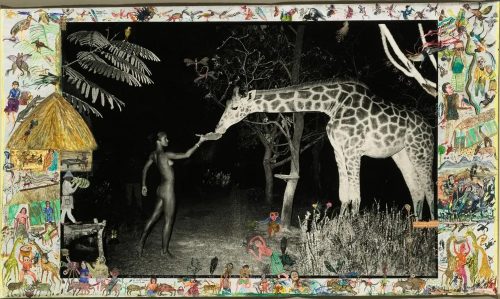
Being interesting is a bit like being beautiful. More often than not, it’s in the eye of the beholder. Personally, I find most of the washed-up shells I see on the beach more beautiful than a highly polished cut-diamond, but a whole lot of people are going to disagree with me on that. In the same vein, the guy at the fuel station might be more interesting than Sigmund Freud - it just depends on your point of view.
That being said, there are people who are UNDENIABLY interesting and, once in a while, you might be lucky enough to cross their path.
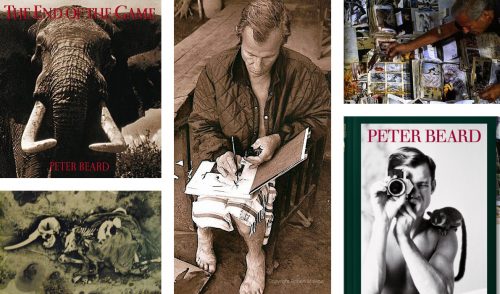
So it was that I once sat down for a drink with Peter Beard, at a sidewalk café in Johannesburg. Born into a wealthy New York family, Beard first travelled to Kenya in the 1950s then returned after his Yale graduation to work in Tsavo National Park, documenting the mass die off of 35,000 elephants – and other wildlife – which formed the core of his 1965 book: ‘The End of the Game’. This provocative tome – overflowing with beauty and horror - captured the harsh reality of starvation, poaching and hunting in Kenya – a reality check at a time when Joy Adamson’s ‘Born Free’ was portraying ‘Wild Africa’ as a sort of Disneyland. More than anything, the enigmatic Beard wanted to portray the truth, like a photojournalist on a warfront. The graphic and sometimes shocking images are more than many people can handle.
Personifying the ‘devil-may-care’ approach of those prosperous enough to be defiant of authority, Beard wanted to show the world how Africa’s ‘game’ – its wildlife – was disappearing. At the same time, he was documenting the end of an era – the end of colonial control. That too was a ‘game’ – a game of intrusion and greed.
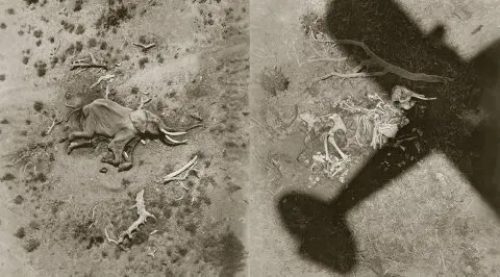
My copy of the second edition of ‘The End of the Game’ is among my most treasured books. Beard’s images of elephants, lions, gazelles and vultures are all in stark monochrome, adorned with layers of his own handwritten notes and quotes from Isak Dinesen (aka: Karen Blixen, with whom he was friends), Roosevelt, Selous and others. Bizarrely, but to make his point, his multi-layered pictures are often smeared with blood. Shocking to many, these visceral images remind us of how powerful and wasteful humankind is.
Styling himself on Hemmingway, with a good dose of Denys Finch Hatton thrown in, Beard was part of New York’s Studio 54 crowd and his unique images of Kenyan wildlife and beautiful women regularly adorned the pages of glossy magazines and calendars. Salvador Dali, Andy Warhol and Francis Bacon were among his friends, and he discovered the Somali supermodel Iman. Peter Beard is essentially a diarist and scrap booker – the camera is just one of his tools - and his photographs often just a canvas for a collage of found-objects, newspaper clippings, woodcuts and other artwork. In some pictures there are gorgeous women, usually naked, among the animals – these being models enticed out to the wilds of Kenya by the dashingly handsome Beard who was just as at home among the Maasai and the thornscrub, as he was with Vogue fashion editors and the jet-set.
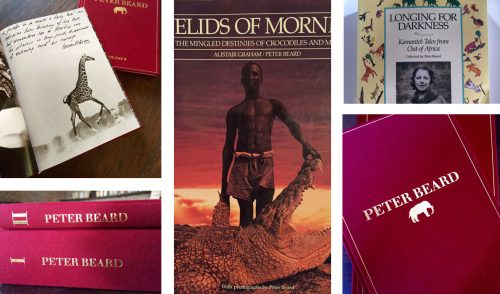
It is now 50 years since ‘The End of the Game’ was published and I’m guessing that Peter Beard might just be surprised at how much wildlife still survives in Africa. The blood of rhinos continues to be spilt and both Black and White are teetering on the brink (again), elephant poaching is out of control in some regions, but the pachyderms are too populous in others. Lions are certainly in big trouble – they have become extinct in several African countries since the book was published, and only seven countries now have populations greater than 1,000. But, the network of protected areas has increased significantly in some countries, and responsible ecotourism operators such as Angama Mara are providing sound economic reasons for local people to safeguard nature. There is hope. Perhaps Beard’s book woke up enough people in time . . .
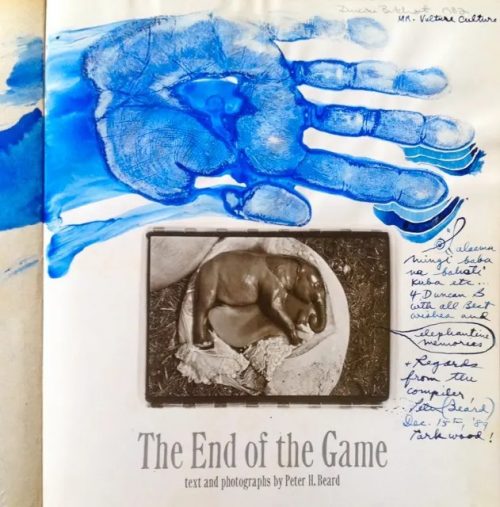
Naturally, I asked Peter Beard to autograph my copy of his book when I met him way back in 1989. This was no ordinary flick of the wrist: he poured half a bottle of Indian ink into a soup bowl, placed his hand in the liquid, then smeared it across the title page! After holding fast for a good fifteen minutes, he took out a nibbed pen and inscribed the book.
Note: Taschen are apparently releasing a 50th anniversary edition of ‘The End of the Game’ – as relevant now as it was back in ’65. If you would like to read Beard’s marvellous books, stay at Angama Mara – every tent each has a copy of ‘Eyelids of Morning’ and ‘Longing for Darkness’. In the lodge library you will find ‘End of the Game’ and his lavishly illustrated visual biography simply titled ‘Peter Beard’.
Filed under: East Africa Travel
Subscribe for Weekly Stories
Comments (1):
3 September 2015
Outstanding post from one exceptional diarist to another....

Angama Image Gallery